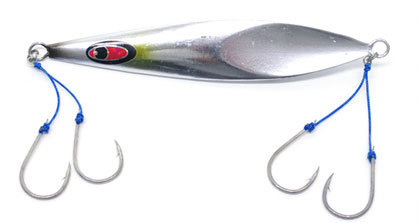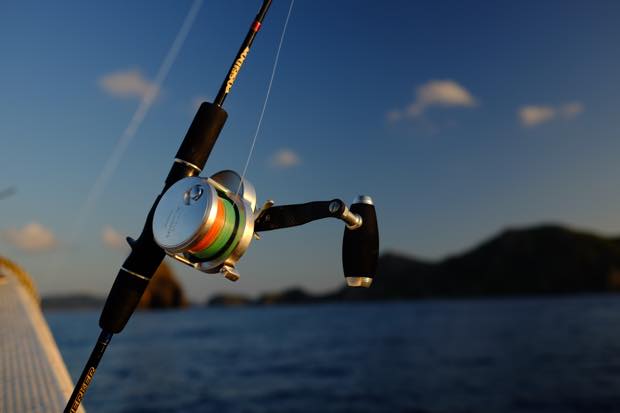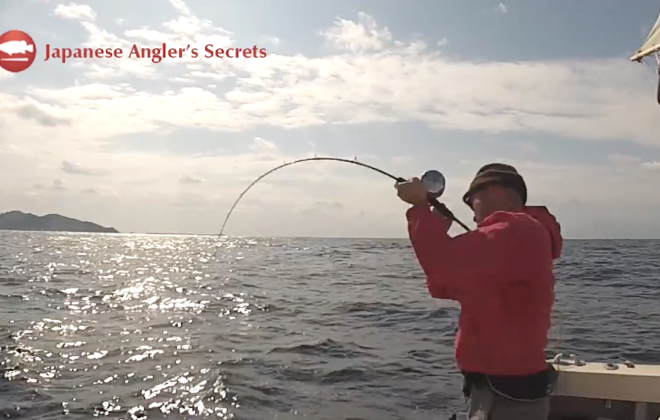PE rating for rod
Here’s a question from a reader.
What does PE rating mean for a rod? The diameter of the line does not appear to make much influence on the rod other than load rating. So is a PE 1-2 rod rated to handle 30lb line fished on a heavy (10kg drag) setting or is it only rated to around 20lb? do I need to go up to pe 3 to handle This drag setting?
PE rating for rod is the indication of the rod strength, indeed. I personally take it as a mere indication of how heavy or light the rod model is in comparison with other models in the same product lineup. It does not tell you how much the drag is supposed to be set at or what line you are supposed to use.
When they test the strength of the blanks, they set the rod horizontally and pull down the tip perpendicularly.
But in the fighting style of slow pitch jigging, we don’t lift the rod. We keep the rod pointing down.
It means there’s much less stress on the rod during the fight.
We use the rod to dance the jig, and we use the reel to fight the fish. So the rod strength indication really doesn’t have practical meanings at all.
In the game of jigging, we don’t cast the jig either. But the rod builders have to come up with the indication of rod strength in the same manner for all the rod types. So let’s give them a break. This is just a rough indication of the max weight that the rod can hold.
In slow pitch jigging, no matter what the rod spec says, PE1.5 to PE2.5 is recommended, and the drag should be set accordingly, usually from 3kg to 5kg. If you are facing the monster that you would have to stop from diving to the rocks, read this post, “How can I catch a monster?“
The same goes with the jig weight indication. Slow Jerker 603-6 says the jig weight of 6oz (170g). Sato Sensei, the designer of this rod, says that this rod is tuned to work in the medium action tone with 170g. This is NOT the max jig weight. (We don’t cast the jig!) 603-6 can handle 100g or less (strong action tone) to 400g or more (soft action tone). AND in the vertical game, the water influence (current and depth) is just as much weight (or more weight) to the rod as the jig. So it’s just a reference point too.
If you want to know the practical jig weight range for each power model, check out this page.
>> Seafloor Control Jig Tactical Info
You need to tune up your senses to know what the strong, medium, and soft setting feels like in the real field. This is the key to the success in slow pitch jigging. The jig weight indication does not tell you what to use and how to use the rod.
Tags In
Related Posts
12 Comments
Leave a Reply Cancel reply
Categories
- 1. SPJ (57)
- 1-1. Principles (9)
- 1-2. Techniques (11)
- 1-3. Setup (17)
- 1-4. FAQ (19)
- 1-5. Tackles (3)
- 1-6. Video Gallery (2)
- 2. Other Offshore Games (5)
- 3. Fishing Report (105)
- 3-1. Totos (25)
- 3-2. Readers (72)
- 4. Fish Cooking (19)
- 4-1. Iki-Jime (3)
- 4-2. The Art of Sashimi (5)
- 4-3. Recipe (7)
- 4-4. Seasoning (3)
- 5. Fishing Charter (6)
- Fish (12)





Hi our Hero
wish u are fine
What it mean max jig weight 130 on shimano game type slowJ rod ?
Thanks
Hi Ahmed.
It just means how heavy the rod is, compared with other models. You can use any weight. Just be aware of what kind of action tone you are in under current conditions.
Ok thanks
What dose
Line 0.8 ▶2.0
Mean
It’s just a way to rate the rod model in comparison with other models on the same lineups. It doesn’t matter much in use of the rod.
i like to get one jig rod..so whats the best choice jig rod. PE 2 4??
Hi Yuzy.
There’s not “best” rod model. The rod model selection depends mainly on the following factors.
– What is your main depth range? If you narrow it to a 30 meter range, what would that be?
– How is your boat operating while fishing? Free-drifting? Drifting with sea-anchor? Or controlled drift by the captain?
– What are your main targets? Pelagic fish? Demersal fish? Or both?
Please study some more through my website and you will have more ideas.
Do you know if kookai wando jig rods are any good and how strong is PE 0.8 ▶#2.0
THANK YOU
It’s a light casting rod, right? It’s not so common and I don’t hear much about it. I just don’t know.
Hi, guys. I loaded pe4 line (tokuryo) to a rod with pe2.5 line weight. Is it okay? Your idea and recommendations are much appreciated.
Hi Jonathan.
I really don’t know a point of rating the rod by line. If they want to rate how heavy/light the rod is, they should rate by Max Drag, which some rod makers do.
The lure weight rating is important when you cast. But not when you are jigging. The jig weight is only a part of the weight that the rod works against. The water resistance can be much more weight on the rod. But some brands have jig weight rating. If the brand is led by slow pitch jigging experts, it means something. “If the condition is such and such and you are likely to use this jig weight, this rod should be sufficient.” There’s common assumption that they rate their rods. But you have to keep in mind that this is from Japan. The assumption comes from a condition that you are on a spankered boat.
Anyway, no matter what line you use, you control the drag. And you also control the angle that you keep your rod at to the line when you fight the fish. If you worry about breaking your rod, you should note that it’s not usually the fish that breaks it. It’s usually how you use it. Sometimes in very special occasions, we do use PE4 on Slow Jerkers too, but we know this is a little unbalanced setting and we have to be careful with how we handle the line tension.
Hi
So does it mean with demon blood 962mh 2/4. I can use pe 4 line 40lb with breakage at 55lb? If i set the drags right?
Another q is. Im thinking to get Spartan s100 4/6. Will this be ok for 60lb fish? With right drag setting? Ive watched lot of aussie YouTubers using pe 8 to 10 rods for big fish.
Hi Chris.
You are asking about the spinning rod for a casting game. I am talking about the overhead rod for a vertical jigging game.
In a casting game, you need to follow the lure weight spec because you cast it. In a jigging game, you don’t have to.
With the spinning tackle, you need to pump the rod because the spinning reel does not have the torque before the spool rotation picks up a momentum. You need a power blanks to bring big fish home. With the overhead tackle on the other hand, you don’t have to pump the rod as much and the overhead reel is powerful enough.
Pumping the rod has a down side. If you don’t do it right, you change the line tension a lot and that may lead to unhooking. As a matter of face, a lot of people pump the rod like trying to come out of the snag. Pumping the rod is effective if you keep the rod 0 – 90 degrees to the line. After 90 degrees, the rod only bends further, and you are only trying to break the rod without bringing the fish any closer.
They are totally different games.